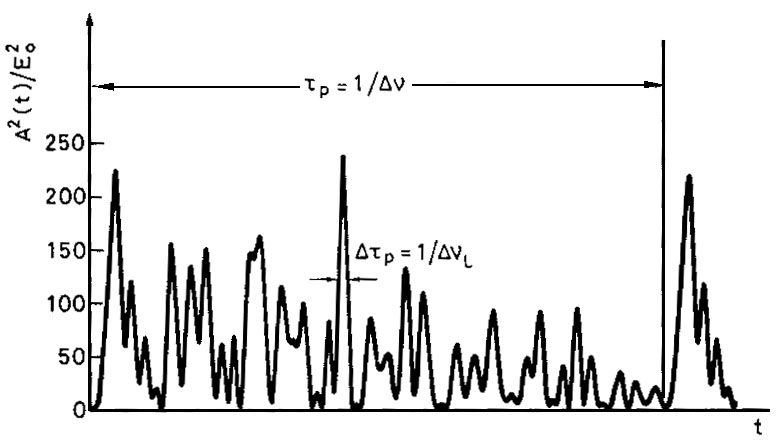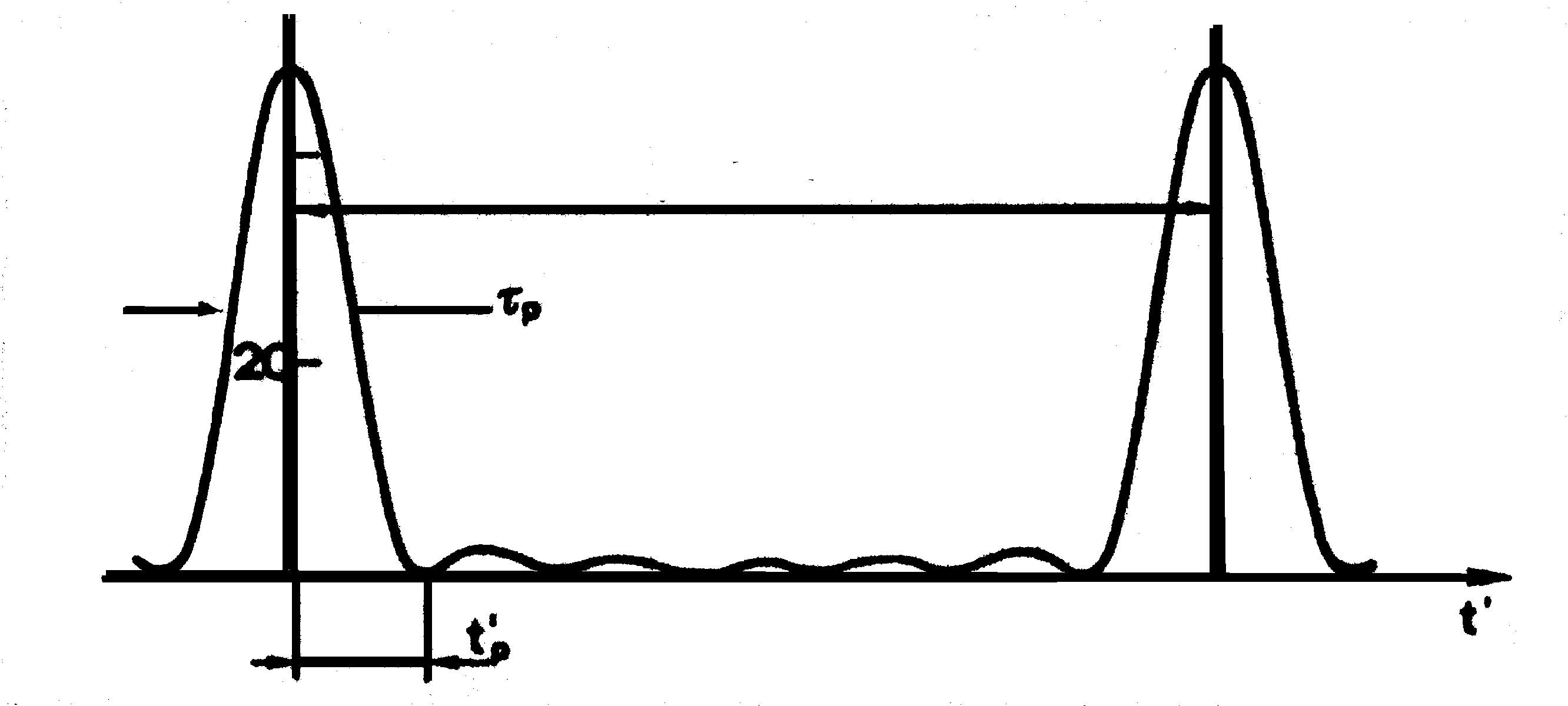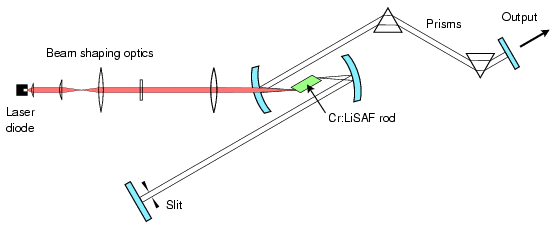Section 2.5: Ultra-short Pulsed Lasers (3)
The above methods are not good enough for generating ultra-short high power pulses. The pulse duration is longer than ns level. If we want the pulse duration to be even shorter, mode locking should be used. With mode locking and other advanced techniques, we can generate pulses with durations from ps to fs level (10-12~10-15 second).
Step four: The idea of Mode Locking
Although single mode oscillation for a laser system is desired for some cases, multi-modes oscillation has the advantage of possible high output power. If we can transform the high energy into the form of ultra-short pulses, we realize both objectives—ultra short pulse and high peak energy. Mode locking does this for us.
Consider a laser oscillating in a large number of longitudinal modes, i.e., standing light waves of different frequencies exist in the laser cavity. We suppose all the modes oscillating with same amplitude. Let D n be the frequency difference between consecutive longitudinal modes. If these modes have no phase correlation, the summation of these waves will appear as the figure below, it is some what random with time while has certain features—the waveform is periodic with a period t p=1/ D n , etc. The output power is N*E02, where N is the number of modes, E0 is the amplitude of the modes.

Figure2.24: Time behavior of the squared amplitude of the total electric field with random phases
Now let’s see what will happen if we let these modes have phase correlation, i.e., if the phases of the modes are locked. Suppose 2n+1 modes are oscillating with the same amplitude E0, and the phase of one mode differs by a constant phase from its next consecutive modes, i.e., j k-j k-1 =j , where we use k to indicate the kth mode. Then the total electric field E(t) is the summation of the modes. We have:
![]()
Where E0 is the amplitude, w 0+k*D w is the frequency of the kth mode, D w is the frequency difference between consecutive modes.
Define A(t) as:
![]()
Then
E(t)=A(t) exp(j w 0 t)
Also define D w *t+j =t’, we can compute A(t’) to be:
A(t’)=E0 sin[(2n+1) D w *t’/2]/sin(D w *t/2)
We know the output laser intensity is proportional to E(t)2, E(t)2µ A(t’)2/E02, we plot the A(t’)2/E02 versus t’ in figure??

Figure2.25: Time behavior of the squred amplitude of the total electric field with locked phases
From above relations, some important conclusions can be drawn:
D t p @ 2p /(2n+1)D w = 1/D n L, D n L=(2n+1)D w /2p
So the bigger the number of modes locked, the sharper the pulse.
Note: we carry out our analysis for very simplified conditions, we have assumed all modes having same amplitude. For a Gaussian shaped amplitude distribution, the time duration is:
D t p @ 0.441/D n L
Now the idea of mode locking is clear. If we can lock the mode to make the modes have fixed phase correlation, we can generate sharp pulses with high peak energy.
 Example: Suppose inside a laser cavity 100 modes are oscillating with same amplitude
E02.
Compare their peak intensity value and pulse duartion time for a) when these
modes have random phases, b) when these modes have same phase.
Example: Suppose inside a laser cavity 100 modes are oscillating with same amplitude
E02.
Compare their peak intensity value and pulse duartion time for a) when these
modes have random phases, b) when these modes have same phase.
Solve: Let the average amplitude of these modes be E02, the maximum intensity possible for the random phase is proportional to 100*E02. The laser intensity has a repetition rate of T0, pulse is not obvious for random phase of so many modes.
The peak intensity for 100modes with same phase is 10000*E02, which is about 100 times of the random case. The laser pulse duration time is T0/100.
Mode locking methods are also divided into active and passive methods. Active mode locking include Amplitude Modulator (AM) mode locking, Frequency Modulator (FM) mode locking and Synchronous Pumping mode locking, etc. We only discuss AM mode locking here, since they most widely used.
For AM mode locking, we insert an AM modulator into the cavity. This modulator adjusts the cavity loss. The cavity loss is very high for some time, light waves with certain phases during this period are attenuated, there is no laser output. Then the cavity loss is very low for some time, light waves with certain phases can oscillate in the cavity. The AM modulator period equals the cavity round trip time, T=2L/c=tp=2p /D w =1/ Dn . In this way the AM modulator locked the modes. AM modulator can be realized by a Pockels cell modulator, or an acoustooptic modulator, etc.
Passive Mode Locking can be realized by fast saturable absorber modulator, slow saturable absorber modulator, Kerr lens mode locking modulator, etc. We introduce Kerr lens mode locking here.
Optical materials like quartz or sapphire have non-linear refractive indexes when sufficiently high intensity light is passing through,
n=n0+n2I
Where n2 is a positive number, I is the incident light intensity.
If the beam is of Gaussian transverse profile, the material has bigger refractive index in the center where the light is stronger, while in the wings of the beam the index is smaller, so the material acts just like a lens, the beam will be focused. We put a suitable sized aperture behind the Kerr optical material, when the light intensity is not big enough, the focus effect is not obvious, dispersion loss is huge, when the light intensity is strong, the beam is well focused into the aperture and passes through. When we place this device correctly in the cavity, mode locking happens. Kerr lens effect is very fast, it can be taken as instantaneous. The fastest mode locked pulses are achieved by this technique using ultra-broadband gain media.
There are more details in mode locking. We stop here hoping the readers have gained some basic knowledge on how pulse can be generated and on how ultra-short high energy pulses can be generated.

G2.10: Schematic of a typical mode-locked diode-pumped Cr:LiSAF laser (Courtesy of Laser Optics and Spectroscopy Group of the Physics Department at Imperial College, London)
Congradualations! You have reached the end of chapter 2, level three. Hoping you are not getting so bored. Please do the following chapter quiz, then move on to next chapter.